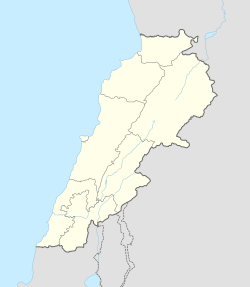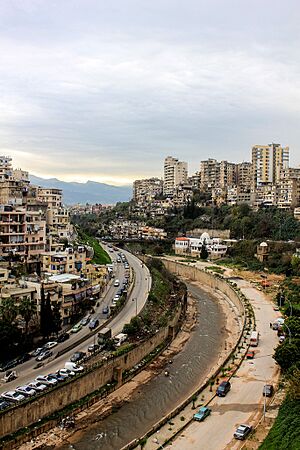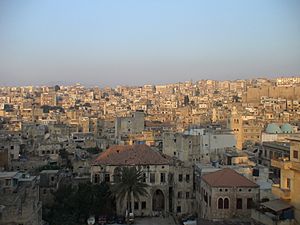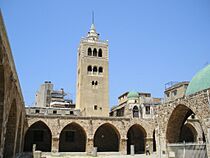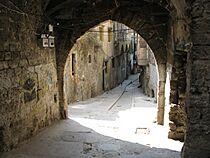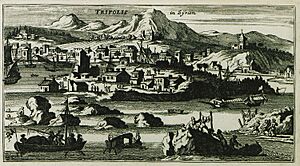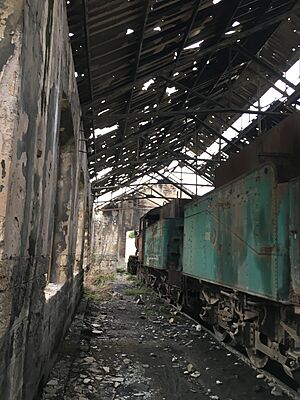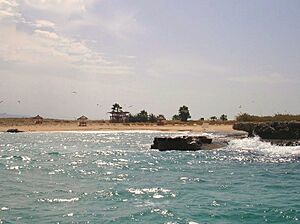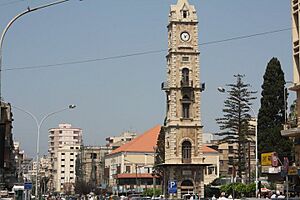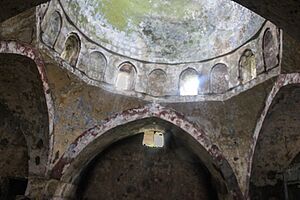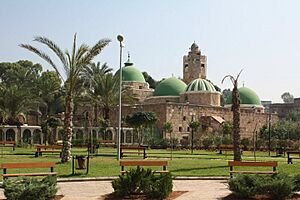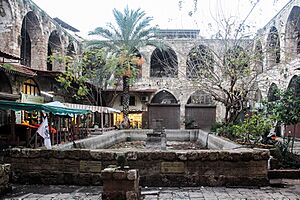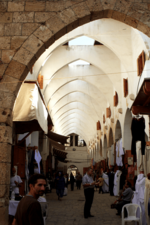Tripoli, Lebanon facts for kids
Quick facts for kids
Tripoli
طرابلس
|
|
|---|---|
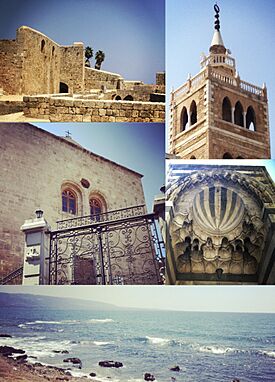
Clockwise from top left: Citadel of Tripoli, Mansouri Great Mosque minaret, Mamluk architecture, bay view, and a Syriac Catholic church
|
|
| Nickname(s):
City of Knowledge and Scholars
|
|
| Country | |
| Governorate | North Governorate |
| District | Tripoli District |
| Area | |
| • Total | 27.39 km2 (10.58 sq mi) |
| Population
(January 2019)
|
|
| • Total | 243,800 |
| Demonym(s) | Tripolitan |
| Time zone | +2 |
| • Summer (DST) | +3 |
| Area code(s) | 06 |
Tripoli (Arabic: طَرَابُلُس) is a very important city in northern Lebanon. It is the second-largest city in the country. Located about 81 kilometers (50 miles) north of Beirut, it is the capital of the North Governorate. Tripoli sits right on the eastern Mediterranean Sea. It is the northernmost seaport in Lebanon. Most people in Tripoli are Sunni Muslims. There are also smaller groups of Alawites and Christians.
Tripoli has a long history, going back to at least 1400 BCE. The Phoenicians called it Athar. Later, Greek settlers named it Tripolis, which means 'Triple City'. This is where the modern Arabic name Ṭarābulus comes from. In the Arab world, Tripoli is known as Ṭarābulus ash-Shām. This helps tell it apart from Tripoli, Libya, which is called Ṭarābulus al-Gharb (Tripoli of the West).
Famous places in Tripoli include the Mansouri Great Mosque and the Citadel of Tripoli. The Citadel is the biggest crusader castle in Lebanon. Tripoli also has many buildings built in the Mamluk style, second only to Cairo. Off the coast, there are four small islands called the Palm Islands. These islands are a special protected area. They are a safe place for endangered loggerhead turtles, rare monk seals, and migratory birds. Tripoli is connected to the city of El Mina, which is its port. Together, they form a larger city area.
After Lebanon became a country and a trade agreement with Syria ended in 1948, Tripoli's economy changed. It used to be as important as Beirut for trade. But it lost its connections with Syria and became less wealthy. The city faces challenges like conflicts between different groups, high unemployment, and economic differences.
Contents
What Does the Name Tripoli Mean?
The name Tripoli has a cool story! Ancient writers like Diodorus Siculus said the city was started by combining settlements from three different Phoenician cities: Tyre, Sidon, and Arwad. These settlements were a short distance from each other. So, the combined city became known as 'Triple City', or Trípolis in Greek.
Tripoli had other names too. In old letters from the 14th century BCE, it might have been called Derbly or Ahlia. The Phoenicians used the name Athar. When the Ancient Greeks arrived, they called it Trípolis, meaning 'triple city'. The Arabs later called it Ṭarābulus. They also added Ṭarābulus al-Šām to show it was the Tripoli in the Levant, different from the one in Libya.
Tripoli was also once known as al-Fayḥāʾ. This Arabic word means something that spreads a pleasant smell. Tripoli used to have huge orange orchards. When the orange flowers bloomed, their sweet scent filled the entire city!
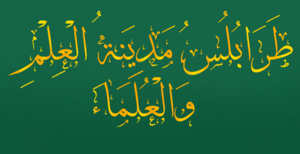
The city is also proudly called "City of Knowledge and Scholars."
A Look at Tripoli's Past
People have lived in Tripoli since at least 1400 BCE. The Phoenicians first set up a trading post here around the 8th century BC. Under Persian rule, Tripoli became a meeting place for Phoenician city-states like Sidon and Tyre. Later, under Hellenistic rule, it was a shipbuilding center and had some freedom. The Romans took over around 64 BCE. A big earthquake and tsunami in 551 CE destroyed the Byzantine city.
An Arab Muslim army conquered Tripoli in 635 CE. During Umayyad rule, it became a busy place for trade and shipbuilding. It gained some independence under Fatimid rule and became a center for learning. But in 1109, the Crusaders captured the city. This caused a lot of damage, including the burning of Tripoli's famous library, Dar al-'Ilm (House of Knowledge), which had thousands of books. During Crusader rule, it was the capital of the County of Tripoli.
In 1289, the Mamluks took over. They destroyed the old port city and built a new city inland, near the old castle. From 1516 to 1918, under Ottoman rule, Tripoli remained important for trade. From 1920 to 1943, Tripoli and all of Lebanon were under French rule, until Lebanon became independent.
Ancient Times
Some historians believe Phoenician civilization in Tripoli started later, around the 8th century BCE. But others think it began earlier because of how Phoenician ports were set up along the coast.
Not much of ancient Tripoli has been dug up because the modern city of El Mina is built on top of it. However, some accidental discoveries have been made. These include animal bones, parts of an old port, and tools. A dig in the Crusader castle found remains from the Late Bronze Age, Iron Age, and later Roman, Byzantine, and Fatimid times.
Tripoli became a major trading port for northern Phoenicia. It traded by sea across the Mediterranean and by land with Syria. Under the Seleucids, Tripoli was allowed to make its own coins in 112 BCE. It had freedom from 104 to 64 BCE. Back then, Tripoli was known for shipbuilding and trading cedar wood.
During the Roman and Byzantine periods, important public buildings were built. These included a stadium, because Tripoli was a key city on the coastal road from Antioch to Ptolemais.
Arab Rule: Umayyad, Abbasid, and Fatimid Periods
Tripoli became even more important for trade across the Mediterranean after the Arabs settled there. It was a port city for Damascus and a major shipbuilding center. It became a wealthy area under the Fatimid rulers.
Jewish people have lived in Tripoli since the seventh century. During the rule of Caliph Uthman (644–655), Jews were settled in Tripoli and lived peacefully with the majority Sunni Muslims. Later, during the rule of the Shi'ite Fatimid caliph al-Hakim (996–1021), a synagogue was turned into a mosque. When the Seljuks invaded in the 1070s, Tripoli was a safe place for Jews from Palestine.
Crusader Period
During the Crusades, Tripoli became the main city of the County of Tripoli. This was a Crusader state founded by Raymond of Saint-Gilles. It stretched from Byblos to Latakia. Tripoli was a busy port and a big center for silk weaving. It had thousands of looms. Other important products were lemons, oranges, and sugar cane. For 180 years, during the rule of the Franks, the Occitan language was spoken in Tripoli. The city had a mix of people, including Western Europeans, Greeks, Armenians, Maronites, Nestorians, Jews, and Muslims.
During this time, the area around the "Pilgrim's Mountain" (the Citadel of Tripoli) grew into a busy suburb. It included important religious buildings like churches. The Knights Hospitaller, a military order, had a major base here, including the famous Krak des Chevaliers castle. The Crusader state ended in 1289 when the Egyptian Mamluk sultan Qalawun captured it.
Mamluk Period
Sultan al-Mansur Qalawun took Tripoli from the Crusaders in 1289. The Mamluks destroyed the old city and built a new one about 4 kilometers (2.5 miles) inland. Around 35 buildings from the Mamluk city still stand today. These include mosques, madrasas (Islamic schools), bathhouses, and inns for travelers. Many were built by local Mamluk princes. The Mamluks did not build new city walls but fixed up and used the old Crusader castle.
During the Mamluk period, Tripoli became a major city and a capital of one of the six regions in Mamluk Syria. It was the third most important city after Aleppo and Damascus. Tripoli was a big trading port, sending sugar, citrus fruits, olive oil, soap, and textiles (like cotton and silk) to Europe.
The Mamluks were the ruling class. Arabs made up most of the population, working in religion, industry, and trade. The city also had its original inhabitants, people who moved from other parts of the Levant, and a minority of Jews. The population of Mamluk Tripoli was estimated to be between 20,000 and 40,000 people.
Mamluk Tripoli grew quickly. The city had seven guard towers at the harbor to protect the inland city. One of these, the Lion Tower, still stands today. The old "Aqueduct of the Prince" was used again to bring water from a spring. Many bridges were built, and the surrounding orchards grew.
The buildings of Mamluk Tripoli are great examples of the architecture of that time. The oldest ones were built using stones from 12th and 13th-century churches. The mosques and madrasas are especially interesting. They have unique designs and decorations, like honeycombed ceilings and fancy doorways. The madrasa al-Burtasiyah is particularly beautiful, with black and white stones on its front.
Public buildings in Mamluk Tripoli were designed to stand out. They used well-cut stones from the area. They often used the ablaq technique, which means alternating light and dark stone layers for decoration. Domes were built over important areas like tomb chambers.
Decorations were focused on the most visible parts of buildings: minarets, entrances, and windows on the outside. Inside, they decorated the prayer niche and walls. These decorations included patterns, carvings, and inscriptions.
Mosques were spread throughout the city, with many madrasas around the Mansouri Great Mosque. Inns for travelers (khans) were in the northern part of the city for easy access from roads to Syria. Public baths (hammams) were placed where many people lived. About 35 Mamluk buildings still exist today. These include six large mosques, 16 madrasas (four of which are gone), and five khans. The three hammams are known for their beautiful domes.
Ottoman Period
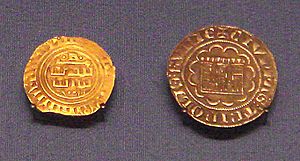
During the Ottoman period, Tripoli became the capital of its own province, called the Eyalet of Tripoli. This province included the coast from Byblos to Tarsus and inland Syrian towns like Homs and Hama. Until 1612, Tripoli was seen as the port for Aleppo. It relied on trade with inland Syria and taxes from the mountains. French merchants were very active in Tripoli in the 17th and 18th centuries. In the 19th century, Tripoli became a smaller administrative center until 1918, when British forces captured it.
The Ottomans restored the Citadel of Tripoli under Suleiman I. This was the only major building project during their 400-year rule. Later governors made more changes to the Crusader castle, using it as a military base and prison. Other buildings from this time include the al-Muallaq or "hanging" Mosque (1559) and Hammam al-Jadid (1740).
French Mandate
After the Ottoman Empire was divided, the French created Greater Lebanon. This new territory separated Tripoli from Syria, which many people in Tripoli did not like. Most of Tripoli's population were Sunni Muslims. They felt isolated in this new state, which was mainly Christian. So, Tripoli became a center for Muslim Arab nationalism and against foreign rule. There were protests asking to reunite with Syria. In 1936, a big 33-day general strike happened.
Independent Lebanon
Since Lebanon became independent, Tripoli has faced economic and political challenges. Beirut grew as Lebanon's main port, which meant Tripoli lost its top spot as a trade hub. The Lebanon's civil war (1975-1990) greatly affected Tripoli. There was intense fighting between different groups. For example, in 1985, a Sunni group and an Alawite group fought, causing many deaths and injuries. The Syrian army stayed in the city for almost 30 years until 2005.
Tripoli did not receive much funding for rebuilding after the war, unlike Beirut. Living conditions have continued to get worse. In 2016, it was estimated that 58% of Tripoli's residents lived in poverty. This number has increased since Lebanon's financial crisis in 2019.
Tripoli's problems are partly due to its complex politics. Different Sunni political figures compete for power, which has led to a lack of clear leadership.
People of Tripoli
Tripoli has a majority Arab, Sunni Muslim population. There is a small Lebanese-Alawite community in the Jabal Mohsen neighborhood. Christians make up less than 5 percent of the city's population today. These include Greek Orthodox Christians, Maronites, and Armenians.
Tripoli is sometimes unstable. It has seen conflicts between its different communities, especially between Sunni and Alawite groups. The Syrian civil war, which started in 2011, has also affected Tripoli. Local Alawites often support the Syrian government, while Lebanese Sunnis support the opposition. This has led to frequent clashes between the two groups in Tripoli.
Tripoli's Weather and Nature
Climate
Tripoli has a hot-summer Mediterranean climate. This means it has mild, wet winters and very dry, hot summers. Temperatures stay moderate all year because of the warm Mediterranean current. So, winters are about 10°C (18°F) warmer and summers are about 7°C (13°F) cooler compared to inland Lebanon. Snow is very rare, happening only about once every ten years. But hail is common in winter. Most rain falls in the winter months, and summers are usually very dry.
| Climate data for Tripoli, Lebanon (elevation: 6m, at El Mina) | |||||||||||||
|---|---|---|---|---|---|---|---|---|---|---|---|---|---|
| Month | Jan | Feb | Mar | Apr | May | Jun | Jul | Aug | Sep | Oct | Nov | Dec | Year |
| Record high °C (°F) | 22.6 (72.7) |
22.6 (72.7) |
30.2 (86.4) |
32.2 (90.0) |
33.9 (93.0) |
35.2 (95.4) |
33.5 (92.3) |
33.2 (91.8) |
31.8 (89.2) |
31.4 (88.5) |
31.4 (88.5) |
25.4 (77.7) |
35.2 (95.4) |
| Mean daily maximum °C (°F) | 16.5 (61.7) |
16.9 (62.4) |
18.6 (65.5) |
21.1 (70.0) |
24.6 (76.3) |
27.1 (80.8) |
29.3 (84.7) |
30.2 (86.4) |
29.5 (85.1) |
27.1 (80.8) |
23.8 (74.8) |
18.9 (66.0) |
23.6 (74.5) |
| Daily mean °C (°F) | 12.8 (55.0) |
13.3 (55.9) |
14.9 (58.8) |
17.5 (63.5) |
21.3 (70.3) |
24.0 (75.2) |
26.2 (79.2) |
27.1 (80.8) |
25.7 (78.3) |
22.8 (73.0) |
19.0 (66.2) |
14.6 (58.3) |
19.9 (67.9) |
| Mean daily minimum °C (°F) | 9.5 (49.1) |
9.8 (49.6) |
11.1 (52.0) |
13.7 (56.7) |
17.1 (62.8) |
19.8 (67.6) |
22.1 (71.8) |
23.0 (73.4) |
21.5 (70.7) |
18.8 (65.8) |
15.4 (59.7) |
10.9 (51.6) |
16.1 (60.9) |
| Record low °C (°F) | −0.8 (30.6) |
3.2 (37.8) |
5.0 (41.0) |
9.2 (48.6) |
11.4 (52.5) |
15.6 (60.1) |
19.0 (66.2) |
20.6 (69.1) |
17.0 (62.6) |
11.2 (52.2) |
8.0 (46.4) |
3.4 (38.1) |
−0.8 (30.6) |
| Average precipitation mm (inches) | 195 (7.7) |
119 (4.7) |
114 (4.5) |
54 (2.1) |
16 (0.6) |
1 (0.0) |
trace | trace | 12 (0.5) |
57 (2.2) |
108 (4.3) |
176 (6.9) |
852 (33.5) |
| Average precipitation days (≥ 0.1 mm) | 13 | 14 | 11 | 6 | 2 | trace | 0 | 0 | 1 | 6 | 8 | 13 | 74 |
| Average relative humidity (%) | 69 | 72 | 70 | 74 | 76 | 75 | 75 | 73 | 69 | 69 | 66 | 72 | 72 |
| Source: Deutscher Wetterdienst(precipitation 1951-1980, precip days 1931-1964, humidity 1959-1967) | |||||||||||||
Offshore Islands: Nature's Haven
Tripoli has several islands just off its coast. The Palm Islands Nature Reserve, also called Rabbits' Island, is the biggest. It's about 20 hectares (50 acres) in size. It got the name "Rabbits" because many rabbits lived there during the French rule in the early 1900s. Now, it's a nature reserve protecting green turtles, rare birds, and rabbits. It was made a protected area by UNESCO in 1992. Camping, making fires, or harming nature there is not allowed. Besides its beautiful scenery, Palm Island also has historical importance. Digs in 1973 found signs of people living there during the Crusader period.
The Bakar Islands, also known as Abdulwahab Island, have been used as a shipyard since Ottoman times. It was called St Thomas Island during the Crusades.
Unlike Palm Island, which has a flat sandy beach, Ramkin Island is mostly made of cliffs and rocks.
Amazing Buildings in Tripoli
Citadel of Tripoli
The Citadel of Tripoli is also known as the Castle of Saint-Gilles. It's named after Raymond de Saint-Gilles, who took control of the city in 1102. He ordered a fortress to be built and called it Mont Pèlerin (Mount Pilgrim). The first castle was burned down in 1289. It was rebuilt many times, including in 1307–08 by Emir Essendemir Kurgi.
Later, the Ottoman Empire rebuilt parts of the citadel. You can still see its huge Ottoman gateway today. Above it is an inscription from Suleiman the Magnificent, who ordered its restoration. In the early 1800s, the Ottoman Governor of Tripoli, Mustafa Agha Barbar, greatly restored the Citadel.
Clock Tower
The Clock Tower is one of Tripoli's most famous landmarks. It stands in Al-Tell square. The Ottoman Sultan Abdul Hamid II gave it to the city. It was built in 1906 to celebrate his 30th year as Sultan. Similar clock towers were built across the Ottoman Empire, like the Jaffa Clock Tower in Israel.
The Clock Tower was fixed up in 1992 and works again today.
Hammams (Public Bathhouses)
When the traveler Ibn Batutah visited Tripoli in 1355, he described the new Mamluk city. He said it was "full of gardens" and had "fine baths."
Indeed, the hammams (public bathhouses) built in Tripoli by the early Mamluk governors were beautiful buildings. Many of them still exist today. Some of the well-known ones are:
- Abed
- Izz El-Din
- Hajeb
- Jadid
- An-Nouri, built in 1333, is near the Grand Mosque.
Oscar Niemeyer's Rachid Karame Fairground
| UNESCO World Heritage Site | |
|---|---|
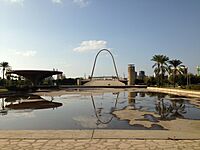
The helicopter landing apron (left) and the gateway arch to the open-air theatre at the Rashid Karami International Fair
|
|
| Location | Lebanon |
| Criteria | Cultural: ii, iv |
| Inscription | 2022 (46th Session) |
| Endangered | 2022–present |
The Rachid Karami International Exhibition Center is a group of buildings designed by the famous Brazilian architect Oscar Niemeyer. He started the project in 1962. It was meant for a World's Fair, but construction stopped in 1975 because of the Lebanese civil war. It was never finished. The site has 15 half-built Niemeyer buildings on about 75.6 hectares (187 acres) near Tripoli's southern entrance.
In 2023, the Rashid Karami International Fair was added to both the World Heritage List and the List of World Heritage in Danger.
Churches
Many churches in Tripoli show the city's long history. They also highlight the different types of Christians living in Lebanon and especially in Tripoli:
- Saint Michael Cathedral (Maronite Catholic)
- St. Elie Greek Orthodox Church
- St. Ephrem Syriac Orthodox Church
- St Francis Roman Catholic Church
- St. Georges Melkite Greek Catholic Cathedral
- Saint Hokekalousd Armenian Orthodox Church
- St. John of the Pilgrims Mount church (Maronite Catholic)
- Our Lady of the Annunciation Melkite Greek Catholic Cathedral
- The National Evangelical Church
Mosques
Tripoli is rich in mosques, with many spread throughout the city. During the Mamluk era, a lot of mosques were built, and many are still standing today.
Some of the well-known mosques include:
- Al-Attar Mosque
- Abou Bakr Al Siddeeq
- Arghoun Shah
- Al-Burtasi Mosque
- Kabir al Aali
- Mahmoud Beik the Sanjak
- Mansouri Great Mosque
- Omar Ibn El-Khattab Mosque
- Sidi Abdel Wahed
- Tawbah Mosque
- Tawjih Mosque
- Taynal Mosque
- Al Bachir Mosque
- Hamza Mosque
- Al Rahma Mosque
- Al Salam Mosque
- Al Ghandour Mosque
- Al Shokr Mosque
- Zafer Bellah Mosque
- Al Wafaa’ Mosque
- Al-Uwaysiyat Mosque
- Mu'allaq Mosque
The Al-Ghuraba cemetery is also located within the city.
Learning in Tripoli
Tripoli has many schools at all levels, both public and private. It also has several universities within the city and nearby.
Some of the universities in and around Tripoli are:
- University of Tripoli Lebanon
- The Lebanese University – North Lebanon Branch
- Universite St Joseph – North Lebanon
- Lebanese International University (just outside the city)
- Al-Manar University of Tripoli (now "City University")
- Jinan University
- University of Balamand (just outside the city)
- Notre Dame University (just outside the city)
- Arts, Sciences and Technology University in Lebanon-North Lebanon Branch
- Beirut Arab University – North Lebanon Branch
- Universite Saint Espirt de Kaslik – Chekka (just outside the city)
- Université de Technologie et de Sciences Appliquées Libano-Française
- Azm university
Tripoli's Economy
Tripoli is one of Lebanon's cities with a lot of economic differences. There's a big gap between wealthy and less wealthy residents. The city faces high unemployment rates.
Trade and Business
Tripoli used to be as important as Beirut for its economy, but it has declined in recent decades. Groups like the Business Incubation Association in Tripoli (BIAT) are trying to bring back traditional businesses. These include making furniture, copper goods, and soaps. They also want to grow new industries like technology services.
The Tripoli Special Economic Zone (TSEZ) was set up in 2008. It offers tax breaks for new businesses that invest more than $300,000 and hire mostly Lebanese workers. This zone is a large area next to the Port of Tripoli.
A plan called "Tripoli Vision 2020" was created to help the city's economy. It aims to encourage investment, provide training, and promote local products. This plan was supported by government officials and business leaders.
The Soap Khan
The Soap Khan (Khan Al Saboun) is an old market built around a square courtyard with a fountain. It has workshops and shops where soap is made and sold. It was started in the late 15th century and finished in the early 16th century. The main ingredient for this soap is olive oil.
Khan el-Khayyatin – The Tailors' Khan
Unlike other khans, the Tailors' Khan, built in the 14th century, is a 60-meter (197-foot) long passage with arches on each side.
Arabic Sweets
Tripoli is famous in the region for its delicious Arabic sweets.
International Connections
Twin Towns and Sister Cities
Tripoli is connected with these cities around the world:
 Naples, Italy
Naples, Italy Larnaca, Cyprus
Larnaca, Cyprus Gaziantep, Turkey
Gaziantep, Turkey Faro, Portugal
Faro, Portugal Toulouse, France
Toulouse, France Miami, USA
Miami, USA Ayia Napa, Cyprus
Ayia Napa, Cyprus
Images for kids
-
Arabic calligraphic representation of the nickname of Tripoli: "Tripoli, The City of Knowledge and Scholars"
-
The Mansouri Great Mosque (late 13th century). The arches and courtyard date from the Mamluk period but the minaret is believed to be an earlier Christian structure.
-
Tripoli gold bezant in Arabic (1270–1300), and Tripoli silver gros (1275–1287), British Museum
See also
 In Spanish: Trípoli (Líbano) para niños
In Spanish: Trípoli (Líbano) para niños


